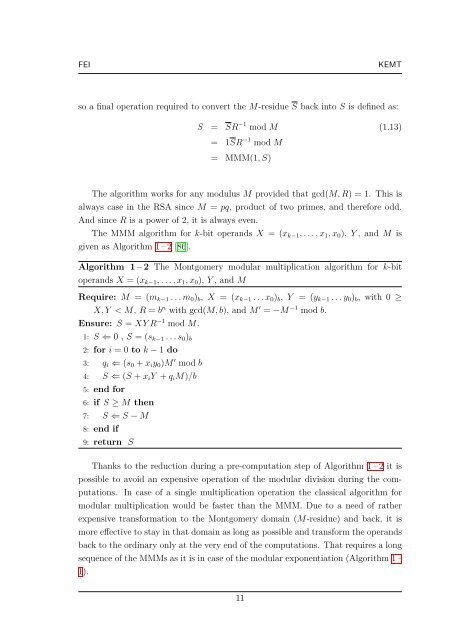1 Montgomery Modular Multiplication in Hard- ware
1 Montgomery Modular Multiplication in Hard- ware
1 Montgomery Modular Multiplication in Hard- ware
Create successful ePaper yourself
Turn your PDF publications into a flip-book with our unique Google optimized e-Paper software.
FEI KEMT<br />
so a f<strong>in</strong>al operation required to convert the M-residue S back <strong>in</strong>to S is def<strong>in</strong>ed as:<br />
S = SR −1 mod M (1.13)<br />
= 1SR −1 mod M<br />
= MMM(1, S)<br />
The algorithm works for any modulus M provided that gcd(M, R) = 1. This is<br />
always case <strong>in</strong> the RSA s<strong>in</strong>ce M = pq, product of two primes, and therefore odd.<br />
And s<strong>in</strong>ce R is a power of 2, it is always even.<br />
The MMM algorithm for k-bit operands X = (xk−1, . . . , x1, x0), Y , and M is<br />
given as Algorithm 1 – 2 [86].<br />
Algorithm 1 – 2 The <strong>Montgomery</strong> modular multiplication algorithm for k-bit<br />
operands X = (xk−1, . . . , x1, x0), Y , and M<br />
Require: M = (mk−1 . . . m0)b, X = (xk−1 . . . x0)b, Y = (yk−1 . . . y0)b, with 0 ≥<br />
X, Y < M, R = b n with gcd(M, b), and M ′ = −M −1 mod b.<br />
Ensure: S = XY R −1 mod M.<br />
1: S ⇐ 0 , S = (sk−1 . . . s0)b<br />
2: for i = 0 to k − 1 do<br />
3: qi ⇐ (s0 + xiy0)M ′ mod b<br />
4: S ⇐ (S + xiY + qiM)/b<br />
5: end for<br />
6: if S ≥ M then<br />
7: S ⇐ S − M<br />
8: end if<br />
9: return S<br />
Thanks to the reduction dur<strong>in</strong>g a pre-computation step of Algorithm 1 – 2 it is<br />
possible to avoid an expensive operation of the modular division dur<strong>in</strong>g the com-<br />
putations. In case of a s<strong>in</strong>gle multiplication operation the classical algorithm for<br />
modular multiplication would be faster than the MMM. Due to a need of rather<br />
expensive transformation to the <strong>Montgomery</strong> doma<strong>in</strong> (M-residue) and back, it is<br />
more effective to stay <strong>in</strong> that doma<strong>in</strong> as long as possible and transform the operands<br />
back to the ord<strong>in</strong>ary only at the very end of the computations. That requires a long<br />
sequence of the MMMs as it is <strong>in</strong> case of the modular exponentiation (Algorithm 1 –<br />
1).<br />
11

















